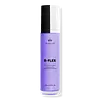What's inside
What's inside
 Key Ingredients
Key Ingredients

 Benefits
Benefits

 Concerns
Concerns

 Ingredients Side-by-side
Ingredients Side-by-side

Water
Skin ConditioningPropanediol
SolventMandelic Acid
AntimicrobialPolysorbate 20
EmulsifyingGlycerin
HumectantGluconolactone
Skin ConditioningLactic Acid
BufferingNiacinamide
SmoothingXylityl Sesquicaprylate
AntimicrobialAnhydroxylitol
HumectantPanthenol
Skin ConditioningPotassium Hydroxide
BufferingHydroxyethylcellulose
Emulsion StabilisingSodium Benzoate
MaskingCitric Acid
BufferingSodium Phytate
Benzoic Acid
MaskingWater
Skin ConditioningCetearyl Ethylhexanoate
EmollientCaprylic/Capric Triglyceride
MaskingGlyceryl Stearate Citrate
EmollientGlycerin
HumectantCetyl Alcohol
EmollientStearyl Alcohol
EmollientGlyceryl Stearate Se
EmulsifyingHelianthus Annuus Seed Wax
Skin ConditioningPanthenol
Skin ConditioningSchinus Terebinthifolia Seed Extract
AstringentAnigozanthos Flavidus Extract
Skin ConditioningPaullinia Cupana Seed Extract
Skin ConditioningHydrolyzed Rhodophyceae Extract
Polyacrylate Crosspolymer-6
Emulsion StabilisingXanthan Gum
EmulsifyingTocopheryl Acetate
AntioxidantPvp
Emulsion StabilisingDipropylene Glycol
HumectantCaprylyl Glycol
EmollientAllantoin
Skin ConditioningSodium Phytate
Vanillyl Butyl Ether
MaskingCitric Acid
BufferingLinoleic Acid
CleansingT-Butyl Alcohol
PerfumingEthylhexylglycerin
Skin ConditioningSodium Chloride
MaskingSodium Sulfate
Linolenic Acid
CleansingPhenoxyethanol
PreservativeChlorphenesin
AntimicrobialParfum
MaskingBenzyl Alcohol
PerfumingBenzyl Benzoate
AntimicrobialHexyl Cinnamal
PerfumingLimonene
PerfumingLinalool
PerfumingCI 42090
Cosmetic ColorantCI 60730
Cosmetic ColorantCI 17200
Cosmetic ColorantWater, Cetearyl Ethylhexanoate, Caprylic/Capric Triglyceride, Glyceryl Stearate Citrate, Glycerin, Cetyl Alcohol, Stearyl Alcohol, Glyceryl Stearate Se, Helianthus Annuus Seed Wax, Panthenol, Schinus Terebinthifolia Seed Extract, Anigozanthos Flavidus Extract, Paullinia Cupana Seed Extract, Hydrolyzed Rhodophyceae Extract, Polyacrylate Crosspolymer-6, Xanthan Gum, Tocopheryl Acetate, Pvp, Dipropylene Glycol, Caprylyl Glycol, Allantoin, Sodium Phytate, Vanillyl Butyl Ether, Citric Acid, Linoleic Acid, T-Butyl Alcohol, Ethylhexylglycerin, Sodium Chloride, Sodium Sulfate, Linolenic Acid, Phenoxyethanol, Chlorphenesin, Parfum, Benzyl Alcohol, Benzyl Benzoate, Hexyl Cinnamal, Limonene, Linalool, CI 42090, CI 60730, CI 17200
 Reviews
Reviews

Ingredients Explained
These ingredients are found in both products.
Ingredients higher up in an ingredient list are typically present in a larger amount.
Citric Acid is an alpha hydroxy acid (AHA) naturally found in citrus fruits like oranges, lemons, and limes.
Like other AHAs, citric acid can exfoliate skin by breaking down the bonds that hold dead skin cells together. This helps reveal smoother and brighter skin underneath.
However, this exfoliating effect only happens at high concentrations (20%) which can be hard to find in cosmetic products.
Due to this, citric acid is usually included in small amounts as a pH adjuster. This helps keep products slightly more acidic and compatible with skin's natural pH.
In skincare formulas, citric acid can:
While it can provide some skin benefits, research shows lactic acid and glycolic acid are generally more effective and less irritating exfoliants.
Most citric acid used in skincare today is made by fermenting sugars (usually from molasses). This synthetic version is identical to the natural citrus form but easier to stabilize and use in formulations.
Read more about some other popular AHA's here:
Learn more about Citric AcidGlycerin is already naturally found in your skin. It helps moisturize and protect your skin.
A study from 2016 found glycerin to be more effective as a humectant than AHAs and hyaluronic acid.
As a humectant, it helps the skin stay hydrated by pulling moisture to your skin. The low molecular weight of glycerin allows it to pull moisture into the deeper layers of your skin.
Hydrated skin improves your skin barrier; Your skin barrier helps protect against irritants and bacteria.
Glycerin has also been found to have antimicrobial and antiviral properties. Due to these properties, glycerin is often used in wound and burn treatments.
In cosmetics, glycerin is usually derived from plants such as soybean or palm. However, it can also be sourced from animals, such as tallow or animal fat.
This ingredient is organic, colorless, odorless, and non-toxic.
Glycerin is the name for this ingredient in American English. British English uses Glycerol/Glycerine.
Learn more about GlycerinPanthenol is a common ingredient that helps hydrate and soothe the skin. It is found naturally in our skin and hair.
There are two forms of panthenol: D and L.
D-panthenol is also known as dexpanthenol. Most cosmetics use dexpanthenol or a mixture of D and L-panthenol.
Panthenol is famous due to its ability to go deeper into the skin's layers. Using this ingredient has numerous pros (and no cons):
Like hyaluronic acid, panthenol is a humectant. Humectants are able to bind and hold large amounts of water to keep skin hydrated.
This ingredient works well for wound healing. It works by increasing tissue in the wound and helps close open wounds.
Once oxidized, panthenol converts to pantothenic acid. Panthothenic acid is found in all living cells.
This ingredient is also referred to as pro-vitamin B5.
Learn more about PanthenolSodium Phytate is the synthetic salt form of phytic acid. Phytic acid is an antioxidant and can be found in plant seeds.
Sodium Phytate is a chelating agent. Chelating agents help prevent metals from binding to water. This helps stabilize the ingredients and the product.
Water. It's the most common cosmetic ingredient of all. You'll usually see it at the top of ingredient lists, meaning that it makes up the largest part of the product.
So why is it so popular? Water most often acts as a solvent - this means that it helps dissolve other ingredients into the formulation.
You'll also recognize water as that liquid we all need to stay alive. If you see this, drink a glass of water. Stay hydrated!
Learn more about Water